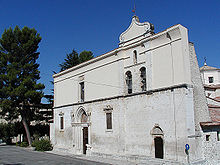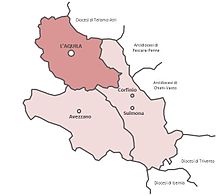History
In the Lombard period Sulmona was subject to the Duchy of Spoleto; later it belonged to the counts of Marsi. When the Normans conquered the Abruzzi, Sulmona increased in importance. In 1233, Emperor Frederick II made it the capital of the "Gran Giustizierato" of the Abruzzi. [1]
Fictional origins
Legend associates the evangelization of the district with the name of Saint Britius, Bishop of Spoleto, in the second century. [2] Local legend in Sulmona credits the evangelization with Saint Feliciano, Bishop of Foligno, in the middle of the third century. He is said to have reconsecrated the temple of Apollo and Vesta as the cathedral of S. Maria Regina de Caelo (Santa Maria in Bussi), which, at the beginning of the 9th century, had its name changed to S. Panfilo. [3] The claim, however, has no evidence to support it. [4]
Early bishops
The first known Bishop of Sulmona is Palladius (499); in 503. Pamphilus of Sulmona, Bishop of Valva, died about 706; he was buried in Sulmona Cathedral.
Four or five other bishops of Valva are known, but none of Sulmona until 1054, when Pope Leo IX named as Bishop of Valva, the Benedictine Domenico, and determined the limits of the Dioceses of San Pelino (Saint Pelinus) (i.e., Valva) and San Panfilo (Saint Pamphilus) (i.e., Sulmona), which were to have only one bishop, elected by the two chapters. [5] On 25 March 1138, Pope Innocent II wrote to Bishop Dodo, reconfirming his possessions and privileges, and mentioning in passing that the bishop had his throne at S. Pelini, in Corfinio (Valva): "Ecclesiam santi Pelini, ubi Episcopalis habetur sedes." [6] The body of S. Pelinus had been transferred to the church of S. Pelino in Corfinio (Valva) in 1124. [7]
Normans
In 1143 King Roger II of Sicily invaded Campania and seized the monastery of Montecassino, all of whose treasures he confiscated. The territory of the Marsi surrendered to him. [8] His sons occupied the territory of Marsi, which included not only the County of Marsi, but the County of Valva. Bishop Dodo was already dead, having died (according to Di Pietro) in 1142. [9] King Roger appointed [10] new bishops at Chieti and Valva. [11]
On 7 April 1168, the cathedral chapter of S, Pelino and the cathedral chapter of S. Panfilo entered into an agreement that both had the right to participate in the naming a bishop. [12]
On 16 October 1256, Bishop Giacomo di Penne, a former monk of Casa Nova, presided over a meeting of the canons of the two cathedrals, at which it was agreed that the two chapters should unite in electing a bishop, as frequent disputes had arisen when they acted separately. [13]
In the winter of 1336/1337, a group of armed men stationed themselves in the cathedral of S. Pamfilo in Sulmona, in order (they said) to prevent others from attacking or occupying it. In the especially cold winter weather, they tore up the flooring of the episcopal palace next door, took out the wooden beams, and made fires to keep warm. The palace was severely damaged. [14]
Other bishops were: Pompeo Zambeccari (1547–1571), nuncio in Portugal from March 1550 to July 1560; [15] Francesco Boccapaduli (1638); and Pietro Antonio Corsignani (1738), the historian of the Abruzzi. [16]
Earthquakes
In the earthquake of 5 December 1456, Sulmona was "for the most part destroyed". [17] On 3 November 1706, a major earthquake devastated Sulmona and Valva. The cathedral of S. Pamfilo in Sulmona was completely destroyed, along with its chapels, and the entire episcopal palace was levelled. [18] Approximately 1,000 people died. [19] Major earthquakes also occurred in 1915, 1933, 1984, and 2009. [20]
French occupation
The see remained vacant from 1800 till 1818. From 1809 to 1815, Pope Pius VII was a prisoner of Napoleon in France, and his policy was not to cooperate with the French in filling bishoprics. [21] When Napoleon did so on his own authority as King of Italy, it created havoc in one diocese after another. [22] The vacancy also saw the occupation of Sulmona by the French, beginning on 6 January 1799, and the suppression of all the religious orders in 1807. [23] When the Congress of Vienna restored the Papal States and the Kingdom of the Two Sicilies in 1815, disputes arose between the Holy See and the Kingdom of the Two Sicilies, involving matters of restoration of church property, and the issue of feudal submission of King Ferdinand to Pope Pius VII. Three years of negotiations were necessary. A concordat was finally signed on 16 February 1818, and ratified by Pius VII on 25 February 1818. Ferdinand issued the concordat as a law on 21 March 1818. [24] The re-erection of the dioceses of the kingdom and the ecclesiastical provinces took more than three years. The right of the king to nominate the candidate for a vacant bishopric was recognized, as in the Concordat of 1741, subject to papal confirmation (preconisation). [25]
On 27 June 1818, Pius VII issued the bull De Ulteriore, in which, in the cases of several dioceses, Sulmona and Valva among them, no change was made from the status quo ante. [26] On 25 September 1818, Pope Pius granted the cathedral of S. Pamfilo in Sulmona the honorary title of "minor basilica". [27]
Reorganization
Following the Second Vatican Council, and in accordance with the norms laid out in the council's decree, Christus Dominus chapter 40, [28] Pope Paul VI ordered a reorganization of the ecclesiastical provinces in southern Italy. On 15 August 1972, a new ecclesiastical province was created, with L'Aquila, which had previously been directly subject to the Holy See, as the new metropolitan archbishopric. The diocese of the Marsi (later renamed Avezzano) and the diocese of Valva e Sulmona were appointed suffragans. [29]
Diocesan unification
On 18 February 1984, the Vatican and the Italian State signed a new and revised concordat. Based on the revisions, a set of Normae was issued on 15 November 1984, which was accompanied in the next year, on 3 June 1985, by enabling legislation. According to the agreement, the practice of having one bishop govern two separate dioceses at the same time, aeque personaliter, was abolished. The Vatican continued consultations which had begun under Pope John XXIII for the merging of small dioceses, especially those with personnel and financial problems, into one combined diocese.
On 30 September 1986, Pope John Paul II ordered that the diocese of Sulmona and the diocese of Valva be merged into one diocese with one bishop, with the Latin title Dioecesis Sulmonensis-Valvensis. The seat of the diocese was to be in Sulmona, where the cathedral was to serve as the cathedral of the merged dioceses. The cathedral in Valva was to have the honorary title of "co-cathedral"; the Chapter of Valva was to be a Capitulum Concathedralis. There was to be only one diocesan Tribunal, in Sulmona, and likewise one seminary, one College of Consultors, and one Priests' Council. The territory of the new diocese was to include the territory of the suppressed dioceses of Sulmona and Valva. The new diocese was made a suffragan of the archdiocese of L'Aquila. [30]
Diocesan synods were held in 1572, 1590, 1603, 1620, 1629, and 1715. In 1572, the meeting was held at S. Pamfilo in Sulmona, but the canons of S. Pelino in Valva, though they attended, presented a memorial claiming precedence over the canons of S. Pamfilo. [31] A diocesan synod was held by Bishop Nicola Jezzoni (1906–1936) in 1929. [32]
A new diocesan seminary was opened Sulmona in 1953. [33]

The Diocese of Nola is a Latin diocese of the Catholic Church in Italy, suffragan of the Archdiocese of Naples. Its seat is the Campanian city of Nola, now a suburb of Naples. Its cathedral is dedicated to the Assumption. The dedication was originally to S. Stephen, the Protomartyr, but after the second reconstruction the dedication was changed to the Assumption. It is traditionally credited with the introduction of the use of bells into Christian worship.

The Archdiocese of Capua is a Latin diocese of the Catholic Church in Capua, in Campania, Italy, but its archbishop no longer holds metropolitan rank and has no ecclesiastical province. Since 1979, it is a suffragan of the Archdiocese of Napoli, i.e. no longer has its own ecclesiastical province nor metropolitan status.

The Archdiocese of Otranto is a Latin archdiocese of the Catholic Church in Italy. The seat of the diocese is at Otranto Cathedral in the city of Otranto, Apulia. It is a suffragan of the archdiocese of Lecce.
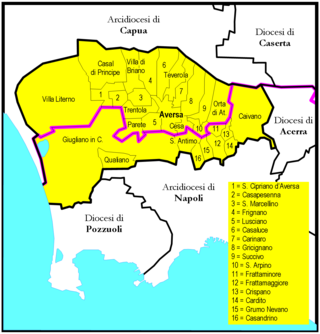
The Diocese of Aversa is a Latin diocese of the Catholic Church in Campania, southern Italy, created in 1053. It is situated in the Terra di Lavoro (Liburia), seven miles north of Naples, and eight miles south of Capua. It is suffragan of the Archdiocese of Naples.

The Archdiocese of Reggio Calabria-Bova is a Latin Church ecclesiastical territory or diocese of the Catholic Church in Calabria, southern Italy. It received its current title in 1986, when the independent Diocese of Bova was suppressed, and the territory and title of the diocese added to that of the Archdiocese of Reggio.

The Diocese of Cassano all'Jonio is a Latin diocese of the Catholic Church in Calabria.
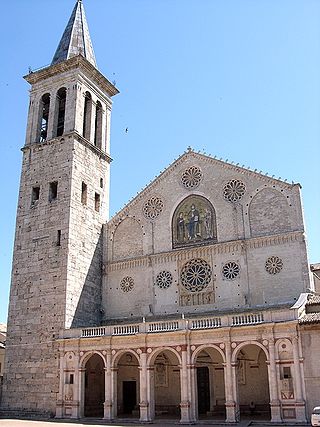
The Archdiocese of Spoleto-Norcia is a Latin Church ecclesiastical territory or archdiocese of the Catholic Church in Italy. Historically, it was the Diocese of Spoleto. Elevated to the status of an archdiocese since 1821, it is a non-metropolitan see and is immediately exempt to the Holy See.

The Diocese of Tivoli is a Latin Church ecclesiastical territory or diocese of the Catholic Church in Latium, Italy, which has existed since the 2nd century. In 2002 territory was added to it from the Territorial Abbey of Subiaco. The diocese is immediately exempt to the Holy See.

The Diocese of Arezzo-Cortona-Sansepolcro is a Latin diocese of the Catholic Church. It has existed since 1986. In that year the historic diocese of Arezzo was combined with the diocese of Cortona and the diocese of Sansepolcro, the enlarged diocese being suffragan of the archdiocese of Florence.

The Archdiocese of Pescara-Penne is a Latin diocese of the Catholic Church on the east coast in central Italy.

The Archdiocese of Chieti-Vasto is a Latin Church diocese of the Catholic Church which received that name in 1986, when the two separate dioceses, which had been governed by one and the same bishop, were united in one diocese. The diocese of Chieti had become the Archdiocese of Chieti in 1526, when promoted by Pope Clement VII. Chieti is about 8 miles (14 km) south-west of the Adriatic port city of Pescara.
The Catholic diocese of Sarsina was a Roman Catholic ecclesiastical territory in Emilia-Romagna, northern Italy, seated in Sarsina, in the province of Forlì, some 32 km south-southwest of Cesena. The diocese was founded in the 5th century, and was suffragan (subordinate) to the archbishop of Ravenna. The diocese existed until 1986, when it was united with the diocese of Cesena.

The Diocese of Conversano-Monopoli is a Latin diocese of the Catholic Church in Apulia. It has existed since 1986, when the diocese of Monopoli was united with the historic diocese of Conversano. The diocese is a suffragan of the Archdiocese of Bari-Bitonto.

The Diocese of Avezzano is a Latin diocese of the Catholic Church in central Italy, whose name in Italian was changed in 1986. It was previously known as the Diocese of Marsi, as it still is in Latin. It has been a suffragan of the Archdiocese of L'Aquila since 1972.
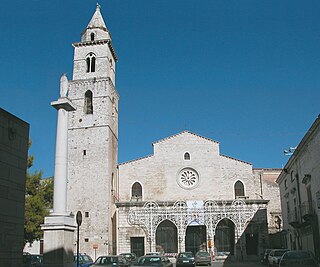
The Diocese of Andria is a Latin diocese of the Catholic Church in Apulia, seated at Andria Cathedral which is built over a church dedicated to St. Peter, about ten miles southwest of Trani. It is a suffragan of the archdiocese of Bari-Bitonto. The diocese has 39 parishes, with one priest for every 1,573 Catholics.
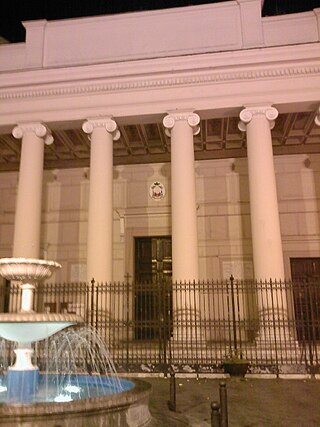
The Diocese of Acerra is a Latin diocese of the Catholic Church in Campania, southern Italy, eight miles east of Naples, in the area once called Terra Laboris (Liburia). It has existed since the 11th century. It is a suffragan of the Archdiocese of Naples.

The Diocese of Sessa Aurunca is a Latin diocese of the Catholic Church in southern Italy. Since 1979 it has been a suffragan of the Archdiocese of Naples.
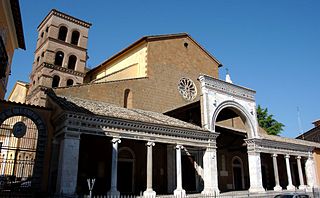
The Diocese of Civita Castellana is a Latin Church ecclesiastical territory or diocese of the Catholic Church in Latium, central Italy. It has existed in the current form since 1986, when the Diocese of Nepi e Sutri was united into the Diocese of Civita Castellana, Orte e Gallese. The Diocese of Gallese had been added to the Dioceses of Civita Castellana and Orte in 1805. The name of the diocese was shortened in 1991, in accordance with Vatican policies. The diocese of Civita Castellana is immediately exempt to the Holy See.

The Diocese of Castellaneta is a Latin diocese of the Catholic Church in Apulia. It is a suffragan of the Roman Catholic Archdiocese of Taranto.

The Archdiocese of Catanzaro-Squillace is a Latin Church diocese of the Catholic Church in Calabria, has existed in its current form since 1986. In that year the Archdiocese of Catanzaro became a metropolitan see, and was combined with the diocese of Squillace.
